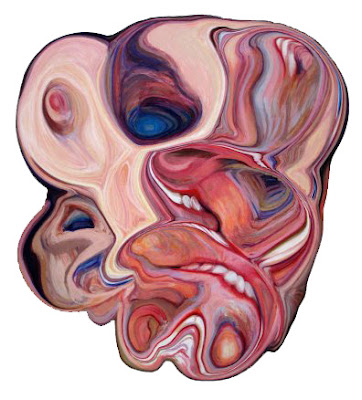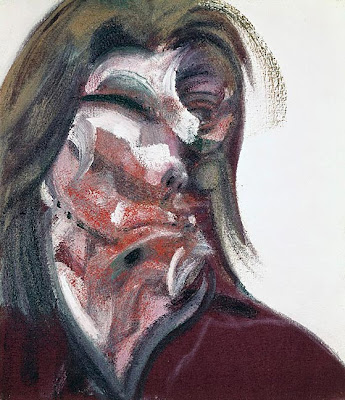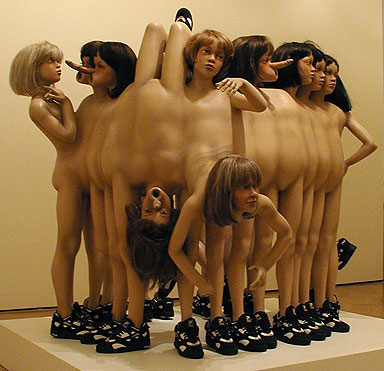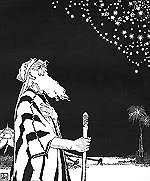GROTESQUE. The chief difficulty encountered in seeking to define the grotesque in its relation to media is—as can be attested to by every theoretician who has sought to do so since the sixteenth century conception of the term in its modern sense—that the grotesque is not an expression of norms, but rather what results from the transgression of them.1 In recognition of the grotesque as “the slipperiest of aesthetic qualities”2 the flurry of nineteenth century writers addressing the grotesque did so by exploring its aesthetic, social and philosophical significance.3 The word itself is rooted in the sixteenth century Italian excavation of ancient palaces, tombs and villas such as Nero’s Domus Aurea in Rome, and the discovery of a fantastical decorative style in the underground chambers called
grotte.4 Within the century the term had spread to France and England, where its definitive scope broadened from decorative motifs to encompass literature and even people.
In the visual arts the original contrastive reference between the staid, classical art expected of Rome and the newly discovered fantasy of interlocking forms and impossible creations evolved into an expression of the ambiguity between reality and non-reality, implied in the modernist aesthetic and fascination with Renaissance mannerism and eighteenth and nineteenth century caricatures, represented most famously in its early stages by Francisco de Goya, Francis Bacon, Hieronymus Bosch and Henry Fuseli.5 The evolution of the grotesque in literary manifestations likewise emphasized the ambiguous relation of modernity to reality, in such early modern authors as Charles (Pierre) Baudelaire, Edgar Allen Poe, (Jean Nicholas) Arthur Rimbaud, Fyodor (Mikhailovich) Dostoevsky, James Joyce, Thomas Mann, Franz Kafka, Carson McCullers and William Faulkner, but often expressed it through curiously one-dimensional caricatures of appearance and behavior, like that exhibited by many of Charles Dickens’ characters.6 In theatre the grotesque as a term found a unique moment of definition in teatro grottesco, an Italian dramatic movement based on Luigi Chiarelli’s play, “
La Maschera e il Volto” (The Mask and the Face) which was appropriately concerned with the opposition of public and private role playing.7 The expansive nature of the grotesque means that its theoretical nature is expressed where art, literature, religion, philosophy, psychology and history (to say nothing of concrete media themselves) intersect, or alternatively the grotesque can itself be seen as their point of intersection. This interaction, as demonstrated in the etymological history of the term “grotesque,” renders a blanket definition even within a single field nearly impossible, the nearest approximation being a chronological chronicle of the evolution of its meaning within a given discipline.
 |
| Mary Murphy : Grotesque 3 |
Theoretical attempts to iron down the meaning and implications of the grotesque have addressed it alternately as a quality of media or as a quality of interaction with media, or even alternatively as a quality of the act of mediation itself. As a quality of media the grotesque has proven particularly susceptible to the conceptual fluctuations of history. Peter Fingesten approaches a theory of the grotesque distinct from historical limitations in his philosophy of necessary theoretical unity, which is that for a cultural product to be truly grotesque it must embody both grotesque concept and grotesque
form.8 The argument for fusion of form and function, however, does little to delimitate the formal distinctions of the grotesque itself. Victor Hugo, one of the first to posit a theory of the grotesque, did so in a primarily contrastive fashion that advocated the merit of the variety of the grotesque to the static monotony of the sublime.9 His theory of the grotesque as a standard bearer of the totalizing tendencies of modern art, which for him would embody life in its representation of all life’s contrasts, including the grotesque and the sublime, was abandoned by later theorists who concerned themselves with specificities of the grotesque as a single term rather than the modern as a universally revolutionary perception of reality. For subsequent critics such as Geoffrey Harpham, the primary task was one of delimitation that separated the grotesque from related terms that might pollute a pure definition of an inherently ambiguous concept.10
This is not to say, however, that more universal theories do not have significant bearing on the grotesque. Indeed, the very interdisciplinary confusion with which grotesque theory struggles seems predisposed to the modern semiotic theories of Pierce11 and Schapiro.12 The proposal of the former on a semiotic system that both recognizes the inherent dynamism of its subjects and that of its own interior process, and the recognition of the latter on a signification of absence as well as presence, might as well be tailored to Hugo’s modernist vision or Harpham’s dilemma of delimitation. In their broader underlying intention, however, they serve as a cogent reminder of the implications of the grotesque, by its very definition (or lack thereof) beyond its own boundaries.
To move beyond itself, however, grotesque theory first focused in. Later definitions relied, like Hugo, on contrast. Rather than focusing on the contrast between the grotesque and other qualifiers, however, they preferred to elucidate the grotesque as itself an embodiment of subservient contrastive elements, usually the horrific and the ludicrous. Rather than contrast the grotesque to the sublime, modern theorists concerned themselves with distinguishing it from similar terms such as the horrific by highlighting the inherent contrastive dimensionality of the grotesque on the one hand with the self-contained and unambiguous related terms on the other. Michael Steig links the theoretical process of distinction concerning the grotesque carried out by Wolfgang Kayser to Sigmund Freud’s distinction of the uncanny and the
fantastic, not in the definitive connotations of the two terms but in their theoretical constructions. For Freud the uncanny is embodied in the strong anxieties produced in an infantile state combined with an infant’s weak ability to manage them, while Kayser finds the grotesque in the combination of the horrific with the comic.13 As Kayser writes, “[the grotesque] appears to us in paradoxical guise … and it elicits from us paradoxical responses.”14 So while the basic foundation of contrast, as a definitive element of the grotesque, has remained fairly constant over its history as a cultural-aesthetic term, the focus and connotation has shifted towards an emphasis on ambiguity.
That is not to say, however, that modern theoreticians of the grotesque are arguing for an evolution of the grotesque itself, but that they are relocating the integral element of significance from inherently grotesque form/function to the grotesque as an
affective description of the act of mediation itself. Kayser, the father of modern grotesque theory, identifies the definition of the term as the central issue in the study of it, assessing it himself as the appearance of a reality that is simultaneously of and opposed to the worlds in which its audience take part.15 Kayser’s focus on definition is not novel, but the direction from which he approaches the issue is. Without abandoning basic concepts such as Fingesten’s unity of form and function he integrates a new concern for effect that unifies grotesque theory from a psychological angle. Such a reevaluation facilitates a comprehensive assessment of the role of the grotesque in history, so that Mikhail Bakhtin can objectively identify the grotesque in its modern manifestation in medieval carnivals, which he argues enacted the fundamentally grotesque inversion of reality by temporarily flipping a closed, hierarchical society into a leveled, democratic world of potential and involvement, although the enactors of such spectacles may not have identified themselves as participants in the grotesque at the time.16 It is the myth of the carnival, both for the participant and the theoretician, rather than the specific reality of the carnival itself, that informs Bakhtin’s philosophy. Bakhtin’s dialogic approach to media facilitates a definition of open mediation as opposed to the closed system created by a presumption of monologic presentation and places the medium and the mediation process in the context of a larger, evolving social world by virtue of the fact that a broader context implicitly underlies a conversational interaction17. Although Bakhtin’s evaluation departs from Kayser’s in the basic optimism of his analysis, which elevates participation in the grotesque as synonymous to participation in an alternate carnival vision of reality, as opposed to Kayser’s conclusion that the grotesque offers not an escape but a realistic way of coping with the often ignored demonic elements of
reality, the process leading to the divergent resolutions is basically consistent. Harpham summarizes the approach in his presentation of the effective standard, a standard based in the temporality of grotesque form versus the fairly constant evocative effect it has historically had upon the viewer and in his own assertion that “Etymological consistency does not equal conceptual accuracy.”18 Indeed, Harpham is uniquely brazen in his recognition of the inherent difficulties of characterizing the grotesque, such that he writes, “In mastering the field, one watches it atomize into fine mist.”19
For Harpham this effect is the establishment through the grotesque of a structure of estrangement, separated from the completely fantastic by the maintenance of the reality of the world while deconstructing the illusion of its basic reliability. Ironically Harpham also recognizes that it is this very effective definition that makes a formative historical definition impossible, for if the grotesque is characterized by the discomfort it effects in its audience, it is then reliant upon the
collective consciousness, the shared culturally and historically specific conventions, beliefs and attitudes of its relative context. For Harpham the inherent unruliness of the grotesque in regards to definition necessitate that a coherent approach recognize that the grotesque as a phenomenon exists in the margins of society, even in a modern social scheme where the boundary between the marginal and the typical seems to blur.20
 |
Francis Bacon
Study for Head of Isabel Rawsthorne
1967 |
The recognition of the grotesque as a phenomenon particularly relevant to modernism has been common to writers from Victor Hugo on, but with an increasing emphasis on the ambiguity and the dissolution of reality in the modern day. It is appropriate, then, that the act of definition should gain new ambiguity in the terms relevant to our own day, in the three fold division of media, mediator and mediation out of which the contemporary lens is constructed.21
Notes
1. Dieter Petzold, "Grotesque,"
The Oxford Encyclopedia of Children's Literature, ed. Jack Zipes, Oxford University Press, 2006
2. Geoffrey Harpham, "The Grotesque: First Principles,"
The Journal of Aesthetics and Art Criticism, Vol. 34, No. 4, 1976: 461
3. Yates opens his introduction to the theoretical history of the grotesque with the assertion that it was such nineteenth century writers as Georg W. Friedrich Hegel, Victor Hugo, John Addington Symonds and John Ruskin that made the grotesque a subject of major critical attention (Wilson Yates, "An Introduction to the Grotesque: Theoretical and Theological Considerations,"
The Grotesque in Art and Literature: Theological Reflections, ed. Adams, James Luther and Wilson Yates, Cambridge: William B. Eerdmans, 1997).
4. Gordon Campbell, ed., "Grotesque,"
The Grove Encyclopedia of Decorative Arts, Oxford University Press, 2006
5. Ian Chilvers, ed., "Grotesque,"
The Concise Oxford Dictionary of Art and Artists, Oxford University Press, 1996 (Oxford Reference Online, 31 January 2008).
6. An interesting side note on the literary side of the grotesque is the recognition of the role of the grotesque in children’s literature, particularly in the grotesque hybridity embodied in Lewis Carroll and C. S. Lewis, as well as in the following categories: the Grotesque of the Abject, taboo violations such as flatulence or excression in the work of Roald Dahl; Grotesque of the Macabre/Black Humor, ranging from the manufacture of the ridiculous through alienating devices such as rhyme and meter (Heinrich Hoffmann’s Struwwelpeter, Hilaire Belloc’s Cautionary Tales (1907)) to the ambiguity of violence and death in Roald Dahl’s Charlie and the Chocolate Factory (1964), George's Marvelous Medicine (1981), and The Witches (1983); sourced as in n. 1.
7. Nick Worrall, "Grotesque, Theatre of the,"
The Oxford Encyclopedia of Theatre and Performance, ed. Dennis Kennedy, Oxford University Press, 2003
8. Peter Fingesten, "Delimitating the Concept of the Grotesque,"
The Journal of Aesthetics and Art History, Vol. 42, No. 4; 1984: 419-426.
9. Victor Hugo,
Preface de Cromwell and Hernani, ed. John Robert Effinger, Chicago: Scott, Foresman and Company, 1900.
10. Harpham goes so far as to distinguish in the central tragic-comedic contrast of the grotesque four spectrum subdivisions: (a) Caricature (novel distortions vs. emphasizing of latent tendencies), (b) Comic-grotesque (ludicrous or satiric), (c) Fantastic grotesque (terrible), and (d) Gothic-macabre ("The Grotesque: First Principles," pp. 461-468).
11. Charles Sanders Pierce, "Logic as Semiotic: The Theory of Signs,"
Semiotics: An Anthology, ed. R. Innis, Bloomington: 1985.
12. Meyer Schapiro, "On Some Problems in the Semiotics of Visual Art: Field and Vehicle in Image-Signs,"
Semiotica, 1, 1969: 223-242.
13. Michael Steig, "Defining the Grotesque: An Attempt at Synthesis,"
The Journal of Aesthetics and Art Criticism, Vol. 29, No. 2, 1970: 253-260
14. Wolfgang Kayser,
The Grotesque in Art and Literature, trans. Ulrich Weisstein, New York: Columbia University Press, 1981.
15. Idid.
16. Mikhail Bakhtin,
Rabelais and His World, trans. Helene Iswolsky. Cambridge, Mass.: M.I.T. Press, 1968.
17. Wilson Yates; sourced as in n. 3
18. Harpham, 461.
19. Geoffrey Galt Harpham,
On the Grotesque: Strategies of Contradiction in Art and Literature, Princeton, N.J.: Princeton University Press, 1982, p. xviii.
20. Yates, 30.
21. Marshall McLuhan,
Understanding Media: The Extensions of Man, New York: McGraw Hill, 1964.
Bibliography
Bakhtin, Mikhail.
Rabelais and His World, trans. Helene Iswolsky. Cambridge, Mass.: M.I.T. Press, 1968.
Campbell, Gordon, ed. "Grotesque,"
The Grove Encyclopedia of Decorative Arts, Oxford University Press, 2006.
Chilvers, Ian, ed. "Grotesque,"
The Concise Oxford Dictionary of Art and Artists, Oxford University Press, 1996 (Oxford Reference Online, 31 January 2008).
Fingesten, Peter. "Delimitating the Concept of the Grotesque,"
The Journal of Aesthetics and Art History, Vol. 42, No. 4; 1984: 419-426.
Harpham, Geoffrey. "The Grotesque: First Principles,"
The Journal of Aesthetics and Art Criticism, Vol. 34, No. 4, 1976: 461-468.
Harpham, Geoffrey Galt.
On the Grotesque: Strategies of Contradiction in Art and Literature, Princeton, N.J.: Princeton University Press, 1982.
Hugo, Victor.
Preface de Cromwell and Hernani, ed. John Robert Effinger, Chicago: Scott, Foresman and Company, 1900.
Kayser, Wolfgang.
The Grotesque in Art and Literature, trans. Ulrich Weisstein. New York: Columbia University Press, 1981.
McLuhan, Marshall.
Understanding Media: The Extensions of Man, New York: McGraw Hill, 1964.
Petzold, Dieter. "Grotesque,"
The Oxford Encyclopedia of Children's Literature, ed. Jack Zipes, Oxford University Press, 2006.
Pierce, Charles Sanders. "Logic as Semiotic: The Theory of Signs,"
Semiotics: An Anthology, ed. R. Innis, Bloomington: 1985.
Schapiro, Meyer. "On Some Problems in the Semiotics of Visual Art: Field and Vehicle in Image-Signs,"
Semiotica, 1, 1969: 223-242.
Steig, Michael. "Defining the Grotesque: An Attempt at Synthesis,"
The Journal of Aesthetics and Art Criticism, Vol. 29, No. 2, 1970: 253-260.
Worrall, Nick. "Grotesque, Theatre of the,"
The Oxford Encyclopedia of Theatre and Performance, ed. Dennis Kennedy, Oxford University Press, 2003.
Yates, Wilson. "An Introduction to the Grotesque: Theoretical and Theological Considerations,"
The Grotesque in Art and Literature: Theological Reflections, ed. Adams, James Luther and Wilson Yates. Cambridge, William B. Eerdmans: 1997.
Ref. Theories of Media : Keywords Glossary : Grotesque








